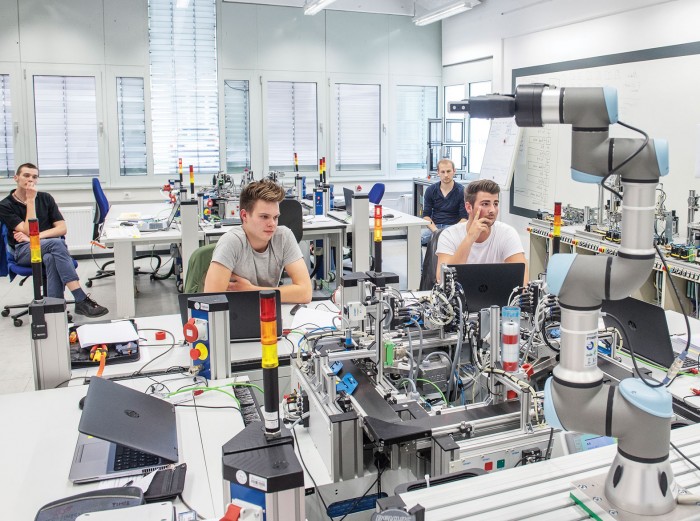Rebuilding Germany’s centuries-old vocational program

Within buildings 10 and 30 of the Siemens complex on the outskirts of Munich, the next generation of German workers are toiling over a range of test projects. The assignments are carefully chosen to impart the skills needed to continue the German miracle in automated manufacturing.
In one room, a group of young men train to be automotive mechatronic engineers. They’ve just spent the past week feverishly programming a diminutive working model of an automated production line—complete with sensors, conveyor belts, and tools that work without human input. They’re able to discuss their work in surprisingly good English, but what sets them apart from their peers in the US is that none of them attend a university.
Most started at Siemens fresh out of secondary school at age 16. Instead of paying tuition and fees—a mechanical engineering program with a mechatronics concentration at a school like North Carolina State University costs some $25,000 to $44,000 a year—trainees receive a small salary while they learn.
The Siemens training is part of a vocational program in Germany that is heralded globally for speeding roughly 500,000 young people a year into the workforce. Last year, the country hit a record high 1.279 trillion euros ($1.51 trillion) in exports. It did this, despite high labor costs, by being the most automated country in Europe, with 309 industrial robots per 10,000 workers. Vocational training is at the heart of this success, and politicians in the US, from both the left and the right, have pointed to it as a system worth emulating.
Such advocates cite the so-called skills gap in many advanced countries: the inability of companies to find people with relevant technical expertise. To close that gap and tackle youth unemployment, Donald Trump last year pledged around $200 million to expand apprenticeship training in the US. Barack Obama started a similar program in 2015.
But some experts warn that Germany’s system will struggle to adapt as the economy grows more dependent on AI and robotics. While AI may provide a long-overdue boost to productivity growth, some say vocational programs could shackle much of the workforce to skills that will soon be outdated. “Germany has shown that they can prepare people for a range of jobs today and over the next decade,” says Eric Hanushek, an economist at Stanford University. “What they haven’t shown is that they are preparing people who are as adaptable when the economy changes.”
Skills for today
The origin of the German apprenticeship, or Ausbildung, program dates back centuries, to when trades were governed by powerful guilds. Some German carpenters still participate in the tradition of going auf der Walz as part of their training—setting out for three years and one day in traditional dress to work as journeymen before returning home to become master carpenters.
Some experts warn that the system will struggle to adapt to AI and robotics.
Today, young Germans get put on a career track, headed toward either university or vocational training, when they are approximately 10 years old; those on the vocational track begin work and training at 16. For around three years apprentices are paid while being trained by an employer like Siemens. Apprentices spend time in a classroom or workshop, where making mistakes won’t hurt the company’s production. Such programs are not cheap, costing businesses around 18,000 euros per year for the average pupil. “The business case for us, when you look at the math,” says Friedrich Beisser, a Siemens consultant for international training, “is that most trainees are productive while they learn, and ready to work right away.”

“Nearly all of them are later hired by the companies where they have made their training,” says his boss, Thomas Leubner, head of learning and education at Siemens. Apprenticeships provide a steady influx of trained workers with just the right skills. And they are loyal, too. In Asia, where churn is typically high, the turnover rate among Siemens employees who’ve apprenticed there is only 3 percent a year, Beisser estimates. The company’s turnover rate in Asia for employees who didn’t train as apprentices is over three times that.
There are other signs that apprenticeship has its advantages. According to a study by Hanushek, recent university graduates in Germany were 12.9 percent less likely to be employed than their vocationally trained peers.
But unemployment goes up and lifetime earnings fall when workers get into their mid-40s. At that age, the outdated skills of someone with vocational training can make it harder to stay in the labor force. University graduates—who learned more generalized knowledge, analytical thinking, problem-solving, and organization, the skills that experts predict will grow increasingly valuable in an AI-driven economy—adapt better.
Signs in economic data from the past few decades support this idea, according to two US-based economists, Dirk Krueger and Krishna Kumar. In the 1960s and 1970s, when per capita GDP growth rose faster in Germany than in the US, technological changes were relatively gradual. In the heyday of the information age, from the 1980s to the 1990s, when American companies adopted new technologies more quickly than their German counterparts, the numbers for the two countries flipped.
During a period of slow change, “training people to do one job, because they can expect to do that job for the rest of their life, is a useful thing,” says Krueger, an economist at the University of Pennsylvania. “But in an economy that’s more rapidly changing technologically, training workers to solve problems as opposed to fixating on one job might be the better alternative.” Perhaps Americans were able to choose the most efficient technology to implement, while a German factory might have been limited to choosing the ones its more narrowly trained workforce had the skills to use.
“I think the German vocational system is probably not particularly well placed to deal with the changes to come,” says Ludger Woessmann, an economist at the University of Munich. For a decade, he says, young Germans have increasingly been choosing university rather than vocational programs. To remain relevant, vocational training will need to change. “For any type of training, particularly for AI and robotics, people cannot build on very job-specific skills for the rest of their lives,” he says. “That’s a fundamental, core problem of any vocational system.”
Midcareer time bomb
But don’t write off the German system just yet. Over the centuries, it “has survived and been adapted to massive changes in technology,” says Kathleen Thelen, an MIT political scientist who wrote a history of it.

To confront the challenges of an AI-driven century, the program has added a newly blended approach, for the lucky few who qualify. Thelen describes it as an elite dual-studies track that confers both a bachelor’s or master’s degree and a traditional apprenticeship credential.
These young people are benefiting from the best of both traditions.
Aurel, one of the young men working in the mechatronics lab at Siemens, told me that after finishing his apprenticeship-only program he'd like to go to university or possibly work at a renewable-energy startup. Downstairs, in the machine shop, a 22-year-old woman named Lena was intently focused on milling what would become the barrel of a small cannon (a personal project intended to spur creativity). She’s earning a university degree while getting paid to work toward an apprenticeship. “I’m doing it for the money,” she told me, “and also because I know I’ll have a job after I finish.” Another young man, Patrick, started as a university student but discovered he could take an extra year to include an apprenticeship with his studies and get paid while he learned. He now trains other apprentices.
The young people in the program are benefiting from the best of both traditions. They also have the advantage of landing placements with a company like Siemens, which can afford to update its training programs frequently; by the end of this year, Beisser says, it intends to introduce a new curriculum that will include AI. But for those locked into more traditional apprenticeships, the future may be less bright.
“The German system doesn’t do very well when it comes to continuing vocational training—that is, retraining at the adult level,” says Thelen. That’s possibly because such training is expensive, and nobody has figured out how to successfully get both companies and adult workers to take part. What’s more, government spending on adult education has gone down in Germany over the past 10 years.
“The traditional view, which is roughly correct, is you learn something at 16, and then you hope that your job basically doesn’t change for the next 40 years, and you retire at age 60,” says Krueger. But as the retirement age creeps above 70 and AI upends a growing number of industries, all bets are off. “And in that world,” says Krueger, “the vocational system will have to adapt quite drastically.”
Keep Reading
Most Popular
Large language models can do jaw-dropping things. But nobody knows exactly why.
And that's a problem. Figuring it out is one of the biggest scientific puzzles of our time and a crucial step towards controlling more powerful future models.
How scientists traced a mysterious covid case back to six toilets
When wastewater surveillance turns into a hunt for a single infected individual, the ethics get tricky.
The problem with plug-in hybrids? Their drivers.
Plug-in hybrids are often sold as a transition to EVs, but new data from Europe shows we’re still underestimating the emissions they produce.
Stay connected
Get the latest updates from
MIT Technology Review
Discover special offers, top stories, upcoming events, and more.